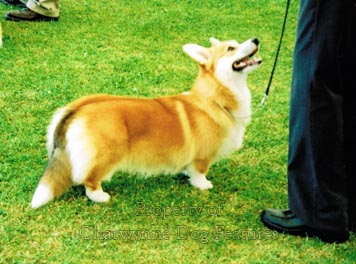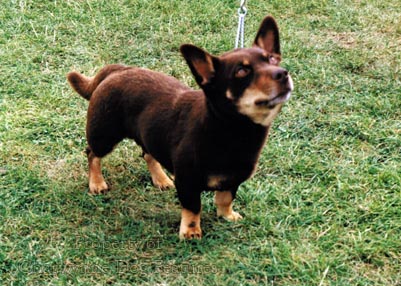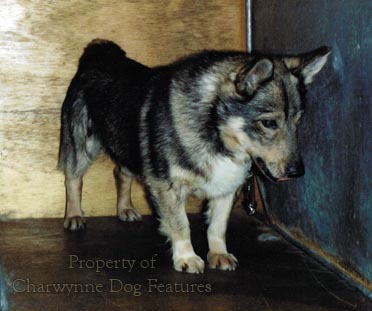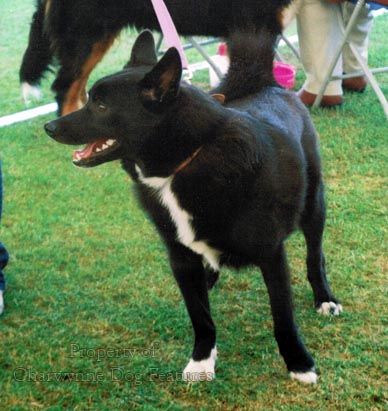384 Hoof-dodgers
THE HOOF DODGERS
by David Hancock
 Here is an exercise for all owners of Corgis, Lancashire Heelers and Australian Cattle Dogs. Go into a field of hefty lively bullocks, get down on your hands and knees and then fail to be intimidated when the cattle surround and menace you. I write this from my memory of a story told to me on the Black Mountain on the Herefordshire/Welsh border, when I was researching the bob-tailed heelers found there. A cattle farmer told me of when he once had a diabetic attack when in a field containing twelve well-grown bullocks. He 'came to' surrounded by determined bullocks but protected by two of his heelers. Lying vulnerably on the ground, he saw the menace his dogs experienced every day, and, for the very first time, from their perspective. This experience gave him a new respect for his agile, steadfast and highly focussed dogs.
Here is an exercise for all owners of Corgis, Lancashire Heelers and Australian Cattle Dogs. Go into a field of hefty lively bullocks, get down on your hands and knees and then fail to be intimidated when the cattle surround and menace you. I write this from my memory of a story told to me on the Black Mountain on the Herefordshire/Welsh border, when I was researching the bob-tailed heelers found there. A cattle farmer told me of when he once had a diabetic attack when in a field containing twelve well-grown bullocks. He 'came to' surrounded by determined bullocks but protected by two of his heelers. Lying vulnerably on the ground, he saw the menace his dogs experienced every day, and, for the very first time, from their perspective. This experience gave him a new respect for his agile, steadfast and highly focussed dogs.
These dogs were not to be trifled with; I was warned not to get out of my car when visiting farms guarded by them, until the farmer emerged to control them. The lady photographer, sent by the magazine which commissioned my article, ignored or forgot this advice and sacrificed a nearly-new pair of wellies! These dogs lived on farms which gave the word remote its full meaning. Without mental toughness and great agility they would never survive their calling. Any 30lb dog facing a one ton beast has my admiration; facing a dozen, with horns as well as hoofs, takes a very special kind of dog.
I am forever surprised when reading of the bull-bait and the boar-hunt, that whilst the pain of the quarry is usually covered, and I have no argument with that, the suffering of the dogs involved never is. Yet in both the bull-bait and the boar-hunt more dogs died than bulls or boars. Barbaric sports like the bull-bait were rightly banned but the barbarity displayed by owners towards their own dogs is rarely referred to. This selective sympathy is echoed today when 'dogs bred for fighting' can be legally destroyed when such a fate should logically be reserved for those who bred them intentionally for employment in such a disgustingly unpleasant activity.
One of the signs looked for by the so-called experts on pitbull type dogs is 'excessive perseverance'. But can you imagine any cattle-heeling dog succeeding without such a quality, and it is one. Did Shackleton, Scott, Amundsen, Nansen and Hillary not display this very attribute? The admirable human pioneers in many fields only succeed because they persevere excessively. It is hardly the sign of a psychopath, human or canine. Dogs serving man by herding horses, driving cattle or coralling wild bulls survive through their great agility, but they are chosen for their courage. Without courage, they wouldn't be exercising their agility. They are remarkable dogs.
The Fila Brasileiro (foolishly not welcome here) is employed by some cattle ranchers in America; it is rightly valued by those who need its courage. An American cattle farmer, Dexter Brunette of Barnesville, bought a Fila as a companion guard but soon found it was an instinctive cattle herder. He now works his dog each day on the farm, taking time out to make it a champion in the show rings of the USA, Puerto Rico and South America. The Fila de Sao Miguel, the Bardino and the Ca de Bou play a similar role, as does the Cao de Castro Laboreiro in Portugal, the Pumi in Hungary and the Cane Corso in Italy.
In America, in Louisiana, the distinctive Catahoula Leopard Dog, with its red or grey merle coat and 'double glass' eyes, excels as a cattle herder, driving semi-wild cattle with great determination. The Florida Cow Dog, now breeding true to type, is earning recognition, not because of its looks, but its prowess. In Switzerland, their native cattle-drovers: the Entlebucher, the Appenzeller and the Great Swiss mountain Dog, are prized, although the latter is better known as a draught dog. In France, the handsome Beauceron, has earned the admiration of many cattle-farmers for its commitment, skill and persistence when working difficult cattle. But the cannier dogs, perhaps, are the heelers. 
I first became aware of the heeler's skill in an unusual way: playing football with a fellow twelve year old who had a Pembroke Welsh Corgi. The dog 'played' football with us, and every time it was threatened by a swinging foot, it flattened instinctively and the foot cleared its head. This was done with remarkable timing. I was impressed; later on, when this dog was mated to a local terrier, I obtained a pup, such was my admiration. This 'drop-flat' technique is a vital survival technique when lashing hooves respond to a small dog's urgings.
Clever experienced heelers will nip the rear foot which the cow is standing on, rather than the one free to kick. The approach is nearly always from behind: a quick nip and away.
This ability was valuable when cattle needed to be moved: in markets or when loading lorries or railway trucks. Short-legged, terrierlike heelers were not an unusual sight in Britain in the last two centuries. If they had been gundogs or hounds whole libraries would be filled with tales of their deeds. But they were used by shepherds and stockmen not squires and little has been recorded of them. But when, as a student fifty years ago, I had summer jobs on farms, it was not unusual to come across small nondescript foxy-headed dogs working cattle. I was reminded of them a few years later when, on an expedition to Norwegian Lappland, I came across Buhund-type dogs on the farms there and Lapphund-type dogs accompanying the Lapps on reindeer drives.
There has been speculation that the Welsh Corgis were taken to Wales by Viking invaders, with the Vallhund of Sweden identified as the source. I am not aware of the 'nip and duck' instincts of Scandinavian breeds, like the Vallhund, the Buhund or the Lapphund, but the Vallhund, whilst having its own distinct breed-type, is remarkably similar to the Pembroke Welsh Corgi. The Senjahund of Finmark is remarkably similar to our surviving English heeler, the Lancashire breed. Pastoral breeds accompanied migrants perhaps more than other types, rivalled only by hounds in value. It is easy to spot British influences in pastoral dogs used in former colonies. I have seen working sheepdogs here which could easily be taken for Australian Cattle Dogs or Australian Shepherds.
The Australian Cattle Dog is respected in many countries for its mental toughness, physical robustness and serious approach to work. In his 'Hunting Big Game with Dogs in Africa', the American Er M Shelley, gave an admiring pen picture of one of these dogs. He described her as: "...a wonderful hunting dog. She could trail nearly as well as a hound, and, when it came to fighting in dense places, I have never seen a dog that could compare with her. She possessed the power and had the courage to force a lion from place to place in dense cover, while large packs of dogs could not move him at all. In after years she was used by Mr Rainey to bring both lions and leopards out of dense reed beds, where his entire pack of forty or fifty hounds and Airedales could not move them."
That is some tribute from a man with immense experience in hunting big game. The Australian Cattle Dog is believed to come from root stock of two Scottish blue merle working collies crossed with dingo, with Dalmatian and Kelpie blood introduced later. I see Bull Terrier features in the anatomies of many ACDs but am told that the outcross to the Bull Terrier was not considered a success and not favoured. The dingo blood is alleged to have produced the inclination to creep up behind cattle and bite them. But there has never been a shortage of British working collies with the instinct to get behind stock and nip it into compliance. I once owned two working sheepdogs which would nip the hocks of cattle as a herding tactic without any training to do so.
The origins of cattle dogs are often the subject of fierce debate. EC Ash, in his Practical Dog Book of 1930, wrote: "...they are a cross of Shetland Sheepdog with the Sealyham Terrier, and possibly Border Terrier..." But nine years later, was writing: "I am of the opinion...that the Welsh Corgi (Pembroke) is an Alsatian cross." About that time, Theo Marples was writing: "Probably the Welsh Sheepdog and the Bull Terrier had a hand in his making." Clifford Hubbard however, who made a comprehensive study of the Welsh breeds, linked the Pembroke variety with Flemish weavers who settled in the Haverfordwest area in the eleventh century. He considered that these migrants brought their Schipperke-like dogs with them to provide an essential ingredient in the emerging breed.
We tend to think of the Schipperke as a solid-black, tail-less dog, associated with Belgian barges and a breed title derived from 'little skipper'. But there are solid fawn and solid blue varieties, some with tails, and another school of thought linking them with dwarf Groenendaels, with a breed title derived from 'little shepherd'. This has some appeal for me; I see strong resemblances between the Schipperke, the Norwegian Buhund, the Iceland Farm Dog, the Norwegian Lundehund, the Norrbottenspets and the Vallhund of Sweden, the West Siberian Laika and the Corgis of Wales. It is always worth keeping in mind that useful dogs travelled with tribes or migrants across many centuries and across many borders.
But what about the only surviving English heeler breed, the Lancashire Heeler? With around 180 being registered annually this breed now appears to have been saved and have a sound future. This is very good news, firstly because we have lost too many of our native pastoral breeds, and, secondly because this is a breed well worth saving. A foot high, smooth-coated, black and tan or liver and tan, lively and perky by nature, they represent an ideal companion dog for many households. I do hope the show ring fanciers keep faith with the historic design of this breed and not produce, in time, Dachshund-like specimens with snipey jaws, bent legs and too low to ground a build. This is essentially a natural unexaggerated working breed, deserving to be conserved as just that.
It is interesing that dogs used with cattle can vary form those substantial enough to impose their will, like the Rottweiler, the Fila breeds, the Gran Mastino de Borinquen of Puerto Rico and the Perro Cimarron of Uruguay, to the little heelers. All these dogs need considerable courage but the little breeds especially so. They combine skill with guts. In his fascinating book, Dogs and their Ways, published in 1863, the Rev. Charles Williams wrote: "Lord Truro told Lord Brougham an anecdote of a drover's dog, whose sagacious conduct he observed when he happened on one occasion to meet a drove. The man had brought seventeen out of twenty oxen from a field, leaving the remaining three there mixed with another herd. He then said to the dog, "Go, fetch them," and he went and singled out those very three." That takes skill and courage.
As long as man needs beef and milk, he will need clever, brave dogs to support him. Butchers may no longer need strong-headed dogs to pin cattle at abattoirs or markets and the droves have long lost their role. But stockmen in many countries still need cattle dogs, dogs agile enough to dodge lashing hooves and sometimes heaving horns too, and brave enough to undertake the task in the first place. These are not just another breed or collection of breeds. They are very remarkable dogs. As the lifestyle of modern man heads towards total urbanization, sporting and pastoral breeds face an uncertain future. We dispense with their skills at our peril; it would foolish indeed to assume that the uncertainties of the future will not in any foreseeable circumstances present a need of such unique talents.
It may be that an international organization of pastoral breeds is called for; most countries developed their own breeds in this field and common challenges have to be faced if a sound future for such admirable creatures is to be planned. I would hate to see brave and talented dogs like these wholly unemployed and just left to fade away. Cattle dogs have never enjoyed noble patronage, featured in fine art or carved a niche for themselves away from the pastures. That may not strengthen their image but should not weaken their case for conservation. The Filas or holding dogs in particular face serious threats in the developed world as ignorant law-makers punish them for the misdeeds of their owners. Yet from the stockpen to the boarhunt such dogs merely did man's bidding; they are well equipped to continue this in many different ways for a long time to come.